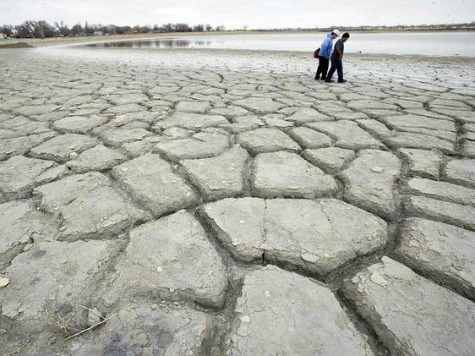The landscaping expert for PBS’ home-improvement franchise This Old House predicts water will be $4 a gallon in order to “cut down on consumption.”
This may sound alarmist, but PBS star Roger Cook is dead serious. Some of the fastest-growing areas in the U.S. are in the Southwest and far West, in areas that are becoming unable to support residents in the style to which they’ve become accustomed–fountains, pools, lush green lawns and all.
Since 1978, This Old House (airs new episodes Thursdays on PBS–check local listings for date and time in your area) as been covering every topic imaginable facing homeowners while renovating residences in its home area of Boston and around the country.
Its companion show, Ask This Old House, lets viewers get answers to specific questions. But for its upcoming 13th season, Ask is doing something special to see just how thirsty the West really is, with the help of Cook, TOH host Kevin O’Connor, and plumbing and HVAC expert Richard Trethewey
Explains producer Heath Racela, in an exclusive note sent to Breitbart News:
We are planning a special, themed episode to begin airing nationally on October 23 on PBS (it will be the fourth episode of our new season). The episode will focus on the Western drought that is affecting homeowners in California, Nevada, Arizona, New Mexico, Texas, and many other states. As always, we offer low-cost, practical solutions for homeowners that can make a big impact in this dry region.
The episode opens with Kevin and Richard touring Lake Mead (in Nevada), which is the largest man-made reservoir in the country, but is only at 40% capacity now! Richard discusses the challenge for drinking water and also hydropower generated at Hoover Dam, as the water levels continue to fall. Water conservation is a huge part of the solution and our experts spend this episode showing some key ways to conserve water.
Irrigation can be 60% of a Western homeowner’s water bill, so Roger tackles the biggest offender — lawns in the desert. Working with a local landscaper, Roger removes a water-guzzling lawn with a more desert-appropriate landscape, and he learns that gardening in the desert isn’t just about cacti and succulents.
In our barn (headquarters), Kevin meets with Weather Channel meteorologist Jim Cantore to learn more about origins of the drought and if this is a short-term or long-term problem.
In Los Angeles last month for the Daytime Emmy Awards, O’Connor and Trethewey sat down with Breitbart News at a diner in West Hollywood to discuss what they found when they visited Lake Mead. It supplies 90 percent of the water in Las Vegas, which is now paying the price for making the desert bloom.
“The whole issue in the West is no water,” says Trethewey. “We saw Lake Mead down 60 to 100 feet.”
According to a recent report from Las Vegas station KLAS-TV, the lake may soon drop below the current lowest level of 1,081 feet, which happened in 2010.
“It’s predicted,” the article says, “the lake could drop to 1,075 in April 2015.”
And this is not just Nevada’s problem.
“It’s the same water source for a lot of places,” says O’Connor. “It’s a huge supplier for California, Nevada. Roger’s story is tearing out the lawn, a huge consumer of water.”
While Las Vegas is attempting to reduce water usage, Trethewey found that San Francisco is actually making it happen.
“It’s all the same watershed,” he says. “(In San Francisco), they’re down to using 40 gallons per person per day, where the average is probably 65 to 80. They’re down by half already, and with water restrictions.”
Even so, a May 19 report in the San Francisco Examiner says, “…The City is edging closer to mandatory water rationing in the coming months.”
This could mean no watering of outside plants, and a lot of sad-looking yards. But it doesn’t have to be that way. Calling in from the current job site in Massachusetts, Cooke has common sense suggestions to help homeowners lower water bills and consumption.
“The first is to water smartly,” he says. “If you’re going to water, that means not in the middle of the day, when it’s going to evaporate, or in such a fashion where there’s more water running down the curb than there is going to your lawn or your plants.”
He suggests using xeriscaping techniques, employing stone and gravel with ground covers, native plants, succulents, etc., that use less water and are more hardy in dry conditions.
As part of its Cash for Grass Rebate Program, Los Angeles County will pay homeowners $1 for every square foot of grass they remove, up to 5,000 square feet. Its tag line is “Take back your Saturday,” and that’s something Cooke agrees with.
“Grass is a great thing when you have a family,” he says, “but really, the most time you spend out on your lawn is when you’re cutting it.”
Westerners with visions of landscaping more suited to the Northeast or Southeast may have to abandon the ideal of the perfect lawn, along with getting used to some other unappealing ideas.
A recent article in Slate on the current California debate over desalinization vs. purification came down financially and energy-wise on the side of purification, saying, “The conclusion here is easy: If drinking purified pee weirds you out, don’t live in a desert.”
If that came to pass, Trethewey assures Breitbart News that it’s not that bad.
“At our Essex House project,” he says, “I didn’t do it on-camera, but I drank the water that had just come out of a self-contained sewage-treatment plant on site. It was like Perrier, just cheaper than Perrier.
“Didn’t have as much fizz.”

COMMENTS
Please let us know if you're having issues with commenting.